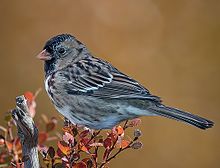Harris's sparrow
| Harris's sparrow | |
|---|---|
 |
|
| Scientific classification | |
| Kingdom: | Animalia |
| Phylum: | Chordata |
| Class: | Aves |
| Order: | Passeriformes |
| Family: | Emberizidae |
| Genus: | Zonotrichia |
| Species: | Z. querula |
| Binomial name | |
|
Zonotrichia querula (Nuttall, 1840) |
|
The Harris's sparrow (Zonotrichia querula) is a large sparrow. Their breeding habitat is the north part of central Canada (primarily the Northwest Territories and Nunavut, ranging slightly into northern Manitoba and Saskatchewan). In fact, this bird is Canada's only endemic breeder. In the winter they migrate to the Great Plains states of the United States, from lower South Dakota to upper Texas. The common name of this species commemorates the American amateur ornithologist Edward Harris (1799–1863).
This species is the largest of the "sparrows" in the family Emberizidae, though other superficially dissimilar species in the family may slightly exceed them in size. They range in total length from 17 to 20 cm (6.7 to 7.9 in), with a 27 cm (11 in) wingspan and weigh from 26 to 49 g (0.92 to 1.73 oz). Among standard measurements, the wing chord is 7.7 to 9.2 cm (3.0 to 3.6 in), the tail is 7.6 to 8.8 cm (3.0 to 3.5 in), the bill is 1.1 to 1.4 cm (0.43 to 0.55 in) and the tarsus is 2.2 to 2.5 cm (0.87 to 0.98 in).
This is a very distinctive looking species. Breeding plumage birds have conspicuous pink bills and black on the crown, face, throat and upper breast, contrasting with grey on the sides of the head and neck. The back is brown, overlaid with heavy black streaking. There are two white wing bars. Breeding birds have white lower underparts with some black mottling on flanks. Non-breeding adults are more buffy than grey and brown, with reduced or absent black markings and often have whitish scalloping on the head and throat. Immatures have less black than all adult plumages, normally marked with a white chin and throat, a black malar stripe and a broad smudgy black breast-band. Juveniles have a brownish crown streaked with black and fine dark streaks and some broader black markings on the underside. Birds moult from July to September. Confusion of wintering birds is possible with the winter Lapland longspur (Calcarius lapponicus) but that species is much shorter-tailed with white outer rectrices, has rich rufous in greater coverts, and is strictly terrestrial on open ground.
...
Wikipedia

